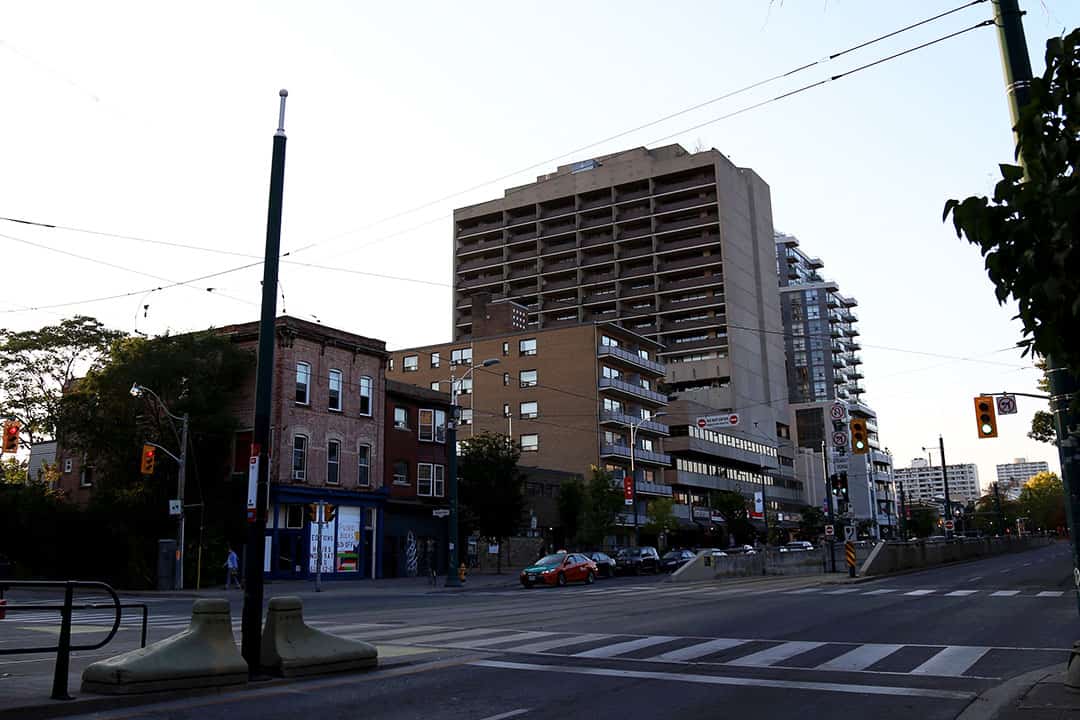After years of negotiations, the University of Toronto has reached an agreement with the City of Toronto and local neighbourhood groups to allow the construction of a new student residence at Spadina Avenue and Sussex Avenue. The building will provide much-needed housing for 511 students and is expected to be completed in 2021.
The student residence will include ground-floor retail spaces, as well as a dining hall, fitness room, and green roofs.
The approval of this building at 698–706 Spadina Avenue and 54 Sussex Avenue — first proposed in 2013 — comes after a long negotiation process between U of T and the city, as well local neighbourhood associations, including the Harbord Village Residents’ Association (HVRA). The latter two disagreed with the university over certain aspects of the residence, including its height, mix of students, and heritage considerations. The building that currently hosts Ten Editions bookstore, at 698 Spadina Avenue, was designated a heritage site in February 2017.
After the city rejected the building proposal in October 2017, the university was able to appeal and enter into provincial mediation at the Ontario Municipal Board (OMB) in an effort to keep the project alive.
In an open letter signed by the HVRA and Councillor Joe Cressy, who represents the ward that U of T and the proposed residence are in, they wrote that U of T being able to enter into provincial mediation was “a fundamental flaw in our planning process… which prevented local communities and the City from guiding decisions on development.”
HVRA Board Member Carolee Orme told The Varsity that “although U of T is generally a good neighbour… our residents made clear that they do not want to become part of the campus and want to be able to determine our own future development.”
“U of T appeared to have difficulty understanding the neighbours’ point of view and showed little interest in substantial compromise prior to mediation.”
U of T Vice-President University Operations Scott Mabury said in an interview with The Varsity that “it was the lack of progress and actually getting agreements in place either from the city or the community that caused [U of T] to appeal to the Ontario Municipal Board, which was ultimately the resolution of this [conflict].”
Mabury said that “the most substantive part of the conversation over the five years” was whether U of T needed a student residence, which is necessary, according to Mabury. This is in accordance with a housing report done by the university in 2017 that found that U of T will need 2,300 new beds by 2020 to keep up with housing demand.
He added that students and student leaders who spoke at public meetings in favour of the student residence were “very powerful and frankly influential in moving the conversation to more productive places.”
The final terms of settlement, released on August 8, came five years after the initial proposal for the building. Mabury’s biggest criticism of the process was its length, saying that “it’s not just my view that it took too long… I think everybody agreed and said to me, ‘This took too long.’”
Compromises on the building
As per the terms of settlement, the height of the building has been reduced from 82.7 metres to 75.05 metres and the number of beds has been reduced from 549 to 511. The student residence will also incorporate the existing building at 698 Spadina Avenue, which was at the centre of a heritage designation dispute that was one of the causes of the long negotiations process.
The settlement also states that the university will attempt to limit the number of first-year students allowed in the residence to 60 per cent. The remaining 40 per cent will be upper-year and graduate students.
U of T has also agreed to renovate the Robert Street Playing Field, located directly west of the proposed residence, and open it to the public. The field is listed as an outdoor complex by the Faculty of Kinesiology & Physical Education and includes an ice rink and tennis courts, which have fallen into disrepair in recent years. The Varsity reported in November 2017 that the ice rink was being used as storage for garbage cans.
In addition to the 23-storey student residence, U of T will also add several townhouses surrounding the tower, which the university says are intended for faculty.
The Varsity has reached out to Cressy for comment.


